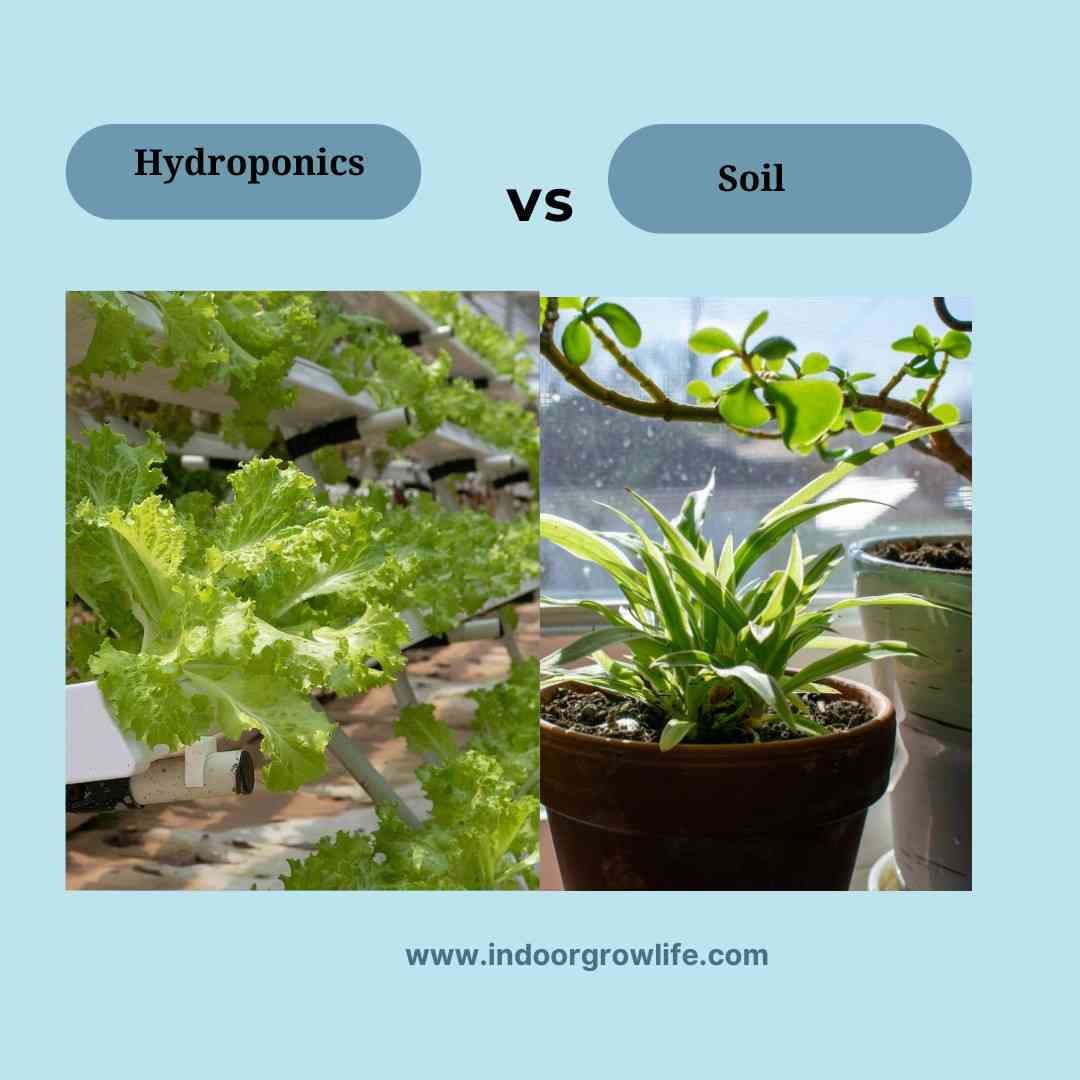Hydroponics vs soil gardening, what’s better? A few years ago, I tried growing lettuce in little pots on our windowsill right after we moved to the Kenyan highlands. We had no yard yet, just a cold room with patchy sun.
I figured, “Hey, I’ve grown in dirt all my life, it’ll be fine.” But nothing grew right. The soil dried out, the seedlings wilted, and I nearly gave up before I found out about indoor hydroponic gardening. That one shift changed everything for our family garden.
If you’re wondering about growing plants without soil versus the traditional method, this post will walk you through the real differences.
Both hydroponic and soil systems can grow food indoors, but each has trade-offs. Hydroponic gardening can speed up growth and use less water, while soil-based growing is cheaper, simpler, and more forgiving for beginners.
Hydroponics vs Soil Pros and Cons
When you grow in soil, you’re using a mix of dirt, compost, and other stuff to hold the roots and feed the plant. It’s what most of us grew up with. You water it, the roots soak it up, and nature does the work of the work, mostly magic, you might add.
Hydroponic gardening skips the dirt altogether. Instead, plant roots sit in water mixed with all kinds of plant nutrients. Some systems bubble air into the water or use pumps, but others, like the Kratky method, just let the roots hang in a still reservoir. It’s a different system, but the plant still gets what it needs: water, nutrients, and oxygen.
Both methods work. The difference is in how each approach delivers nutrients and how much control you have over the growing process. And that’s what this post is all about.
Indoor Hydroponic vs Soil Systems: How Each System Works
Soil gardening indoors: Soil is simple. You need a pot, potting mix, seeds, and a sunny windowsill. Water when dry, and the roots pull what they need from the mix. It’s the old-school way and works fine indoors for herbs, leafy greens, or even cherry tomatoes.
Indoor hydroponic gardening (Kratky Style): Hydroponics takes a bit more setup upfront. Here’s what a basic passive hydroponic system (like Kratky) needs:
- A container (5-gallon buckets or food-safe bins work well)
- A lid with holes for net cups
- Net cups to hold your seedlings
- A growing medium (like clay pebbles or rockwool)
- Nutrient solution mixed into water
The plant’s roots dangle into the nutrient water, and as they grow, they take in what they need. With Kratky, there’s no pump; you’ll have to top off the water every so often. That’s the method I started with, and I still use it for growing lettuce and basil.
There’s at least 7 hydroponic systems, and not every indoor gardening setup works great for those starting out. I suggest you spend a minute reading that post and see if you’d like at least one of them.
If you’re not facing power issues where you’re at (and no economic constraints) and want to level up, you can try systems that circulate water or use air pumps. But for most beginners, I recommend keeping it passive and cheap and building up to more complex systems as your experience and needs evolve.
Hydroponics vs Soil: Side-by-Side Comparison
| Feature | Hydroponics | Soil |
| Setup | More complex (needs materials + know-how) | Simple (pot, soil, seed, water) |
| Growth speed | Faster (25–30% faster in my case) | Slower, but steady |
| Water use | Super-efficient, recirculates or stays put | Requires frequent watering |
| Cleanliness | No dirt, less mess | Can be messy indoors (not for people who love their nails too much) |
| Pests | Fewer pest problems indoors | Prone to fungus, gnats, and soil bugs |
| Forgiveness | Less forgiving if setup fails | Plants usually bounce back easily |
| Cost | Higher upfront costs | Cheaper to start |
| Learning curve | Steeper, needs some new knowledge | Familiar for most gardeners |
Hydroponics vs Soil Gardening Pros and Cons from a Homesteader
Hydroponics Pros:
- Faster growth. My lettuce grows about 25–30% quicker in water than it ever did in pots. I’ve even seen scienttific studies saying they grow up to 50% faster.
- Uses less water. Once you mix your solution, it mostly stays put or recirculates.
- Clean. No bags of soil, no mess on your kitchen floor.
- Space-efficient. You can tuck hydro setups on shelves or under grow lights.
Hydroponics Cons:
- More setup: You’ll need containers, nutrients, and a basic understanding of pH and water levels.
- If something goes wrong, your plants can die fast.
- Can feel technical. Mixing nutrients was nerve-wracking at first, but it gets easier.
Soil Pros:
- Cheap and easy to start. Just grab a pot, some mix, and you’re good to go.
- Forgiving. Overwatered? Underwatered? Soil plants usually bounce back.
- Feels natural. Especially if you’re used to outdoor gardening.
Soil Cons:
- Slower growth. Not too much of a difference, but definitely noticeable.
- More pests. Fungus and gnats love damp indoor soil.
- Messier, especially with kids or pets knocking things over.
Do Hydroponics Plants Grow Faster Than Soil-Grown Ones?
Plenty of solid studies have shown that, on average, hydroponic plants grow faster than soil-grown ones indoors, so long as both get enough light and nutrients.
The University of Minnesota Extension says hydroponic growing leads to faster growth and higher yields than traditional soil gardening. With artificial lights, you can grow hydroponically all year long.
According to the University of Nevada, Reno, hydroponic systems give you more control over growing conditions, which helps boost crop yields and speeds up growth.
The University of Illinois Extension reports that hydroponic plants grow 30% to 40% faster than those grown in soil, and they usually produce more.
Several credible studies back these claims up with real stats. A 2024 study in the African Journal of Agricultural Research found that Swiss chard grown in a hydroponic setup grew faster and had bigger leaves than the same plants grown in soil.
And a 2014 study from An-Najah National University (Palestine) showed that hydroponic plants grew 30% to 50% (PDF) faster than those in soil, based on performance data from a wide range of plants.
Why Do Hydroponic Plants Grow Faster Than Those Grown With Soil?
Hydroponic systems send nutrients straight to the plant’s roots through water, so plants absorb them faster and more consistently according to this peer-reviewed study. In soil, nutrients have to break down and move through the dirt first, which slows things down.
In addition, with hydroponics, you get to decide the exact amount of light, water, and nutrients your plants get. According to the University of Minnesota Extension, that kind of control creates steady, low-stress conditions ideal for strong, even growth.
The best part? Since hydroponic systems are indoors and don’t rely on soil or seasons, you can grow crops anytime, no matter the weather or time of year.
What I’d Tell a Friend Starting Indoors
When folks message me asking what to start with, I ask two things:
Question #1: Do you like tinkering?
Question #2:How patient are you?
If you’re the kind of person who enjoys setting things up and checking on your plants like they’re a mini science project, indoor hydroponic gardening can be really fun.
Many people start with a Kratky bucket in their pantry or on the counter. No pumps or no timers, just a lid with a hole and some nutrient-rich water. My lettuce loved it. The kids did too. And I didn’t miss sweeping up spilled dirt.
But if you’re stretched thin or just want something you can water and walk away from, soil might be your best indoor growing method. A good potting mix and a sunny window will still give you fresh herbs or greens. It might grow slightly slower, but it’s much easier to manage.
One witty grower on a Reddit thread said, “Hydroponics feels like babysitting plants. Soil feels like raising them.” I get that now. With hydro, you’re the lifeline. With soil, nature handles a bit more.
Wrap-Up: Start Simple and See What Works for You
Don’t overthink it. Just start small and see what fits your life. Try a pot of basil in soil and a jar of lettuce in a Kratky setup. You’ll figure out fast what you enjoy, what fits your space, and what you’re more likely to keep up with.
At the end of the day, the goal’s the same: grow something good at home and enjoy doing it.

Patrick M. holds a degree in horticulture and has over 10 years of experience as a senior production manager at Syngenta. He also completed advanced training in plant breeding at Texas A\&M. His work in Kenya, Norway, Sweden, and Denmark brings a wealth of practical insight to his writing on IndoorGrowLife.com. Patrick is passionate about helping people grow fresh food indoors using hydroponic systems.

